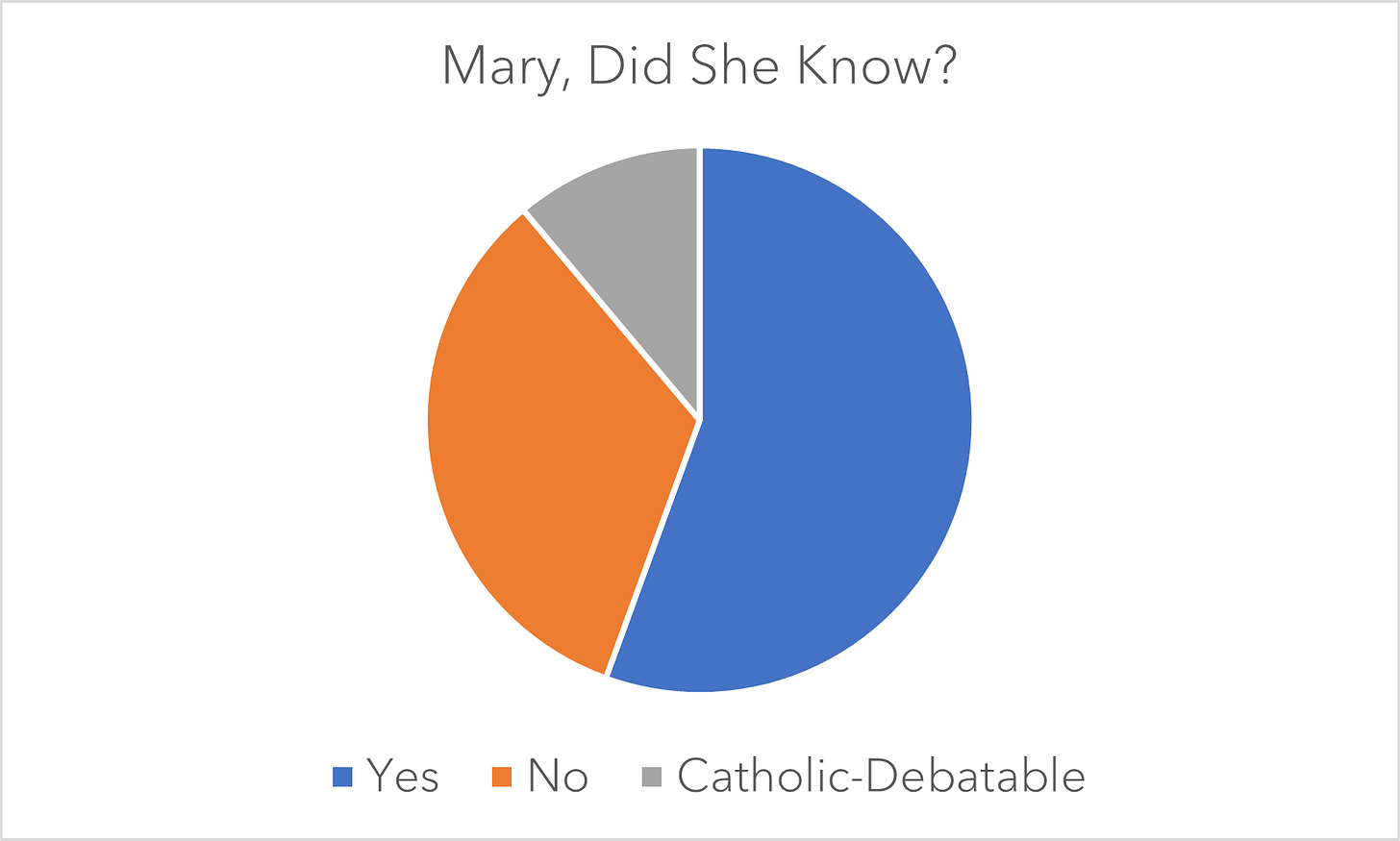What Did Mary Know? And When Did She Know It?
[Trivia: can you name all 12 types of presents from the 12 days of Christmas?]
What did Mary know and when did she know it?
Lots of people have strong opinions about Mark Lowry’s 1984 song “Mary, Did You Know?” The typical criticism is that yeah, Mary knew, obviously. The typical response is that it’s a lovely song regardless that taps into feelings of wonder.
And I do think that the place to begin is that Mary was in fact pretty knowledgeable. Let’s recap what’s related in the relevant gospels (Matthew and Luke), but first remind ourselves what, in fact, the song asks about.
The song’s lyrics ask several different questions, from the grindingly obvious “Mary did you know that your baby boy is Lord of all creation?” to the really fanciful “Mary did you know that your baby boy would one day walk on water?”
It was pointed out to me reading about this song that one line has generated controversy in Catholic circles even though it isn’t even a question, namely, “This Child that you delivered will soon deliver you,” as in, “Catholic commentators have often questioned a particular line of text that might confuse or challenge the belief that Mary herself was conceived without sin.” Ironically, that’s been the one line of the song that I find myself enjoying, since it feels like the song’s one line of inspired wordplay.
But anyway—Mary definitely knew some of these things. An angel appears to Joseph and says (Matthew 1 ESV) “Joseph, son of David, do not fear to take Mary as your wife, for that which is conceived in her is from the Holy Spirit. She will bear a son, and you shall call his name Jesus, for he will save his people from their sins.” I think it’s only reasonable, under the circumstances, to assume that Joseph shared that with Mary. It’s possible he didn’t, but unlikely.
Meanwhile, Luke 1 relates how the angel Gabriel comes to Mary and says
Do not be afraid, Mary, for you have found favor with God. And behold, you will conceive in your womb and bear a son, and you shall call his name Jesus. He will be great and will be called the Son of the Most High. And the Lord God will give to him the throne of his father David, and he will reign over the house of Jacob forever, and of his kingdom there will be no end . . . The Holy Spirit will come upon you, and the power of the Most High will overshadow you; therefore the child to be born will be called holy—the Son of God. And behold, your relative Elizabeth in her old age has also conceived a son, and this is the sixth month with her who was called barren. For nothing will be impossible with God.
The basic message is clear. Although I have to say, going through the song’s questions, they actually seem to break down into “yes, by nature of his being God the Son” and “probably not, that’s oddly specific.” I mean, sure, maybe Mary received some divine communication, by angel or vision, about Jesus’ specific future miracles that the gospels don’t relate in detail. It’s possible—but there’s nothing that really makes us entertain it as a distinct possibility, and I’m not inclined to give the song the benefit of the doubt given the first set of questions, which are all answered with a resounding “Duh.”
Anyway, by my enumeration (enumerations can be dicey), there are nine distinct questions and they break down thus:
. . . and it’s actually obnoxious, from an assessing point of view, that so many of the questions are actually the open-ended “Mary, did you know?” of the chorus. Know what exactly? What is that question asking about? It isn’t communicated. (Therefore I just didn’t include it in my pie chart.) And there are more repetitions of that question than there are unique other questions!
And since I don’t want to flood this substack with post after post about Mary, I may as well add here now something that I came across when I wrote about God closing doors and opening windows (way back in May). So, the Book of Concord (the core text across Lutheranism) discusses Christ’s presence in communion with this little theological discussion. “The one body of Christ [says Luther] has a threefold mode or all three modes of being anywhere,” it says. And it discusses one relevant mode thus (all of the bracketed text below is original to bookofconcord.org—not mine, for a change):
Secondly, the incomprehensible, spiritual mode, according to which He neither occupies nor vacates space, but penetrates all creatures wherever He pleases [according to His most free will]; as, to make an imperfect comparison, my sight penetrates and is in air, light, or water, and does not occupy or vacate space . . . This mode He used when He rose from the closed [and sealed] sepulcher, and passed through the closed door [to His disciples], and in the bread and wine in the Holy Supper, and, as it is believed, when He was born of His mother [the most holy Virgin Mary].
If I’m reading this correctly, this is warmly referencing (though not throwing its whole weight behind) a belief that Jesus was born, um, by like phase-shifting through Mary’s pelvic area to get to the outside rather than actually having a birth-canal birth? Well. Huh. (Greek corner: no, there isn’t anything about the word, “tikto,” used in Matthew 1:23 and also multiple times in Luke 2 to mean “to give birth,” that suggests a non-literal or otherwise metaphorical birth. It’s the normal word meaning “to give birth.”) (More Greek: apparently the word is related to the Greek words for “builder” and therefore “craft”—ultimately, I think you could say that we have great-nephews of the Greek verb meaning “to give birth” in our words “technique” and “technology.”)
But anyway, I will acknowledge that the “Mary Did You Know” song reminds me of that conclusion of Luke’s Nativity narrative, where the shepherds “went with haste and found Mary and Joseph, and the baby lying in a manger. And when they saw it, they made known the saying that had been told them concerning this child. And all who heard it wondered at what the shepherds told them. But Mary treasured up all these things, pondering them in her heart.”
So something about it, indeed, echoes something that we know about Mary’s character or personality.
But I think the point, or meditation, could have been made a little more intelligently.
~
Answer: 12 drummers drumming, 11 pipers piping, 10 lords a-leaping, 9 ladies dancing, 8 maids a-milking, 7 swans a-swimming, 6 geese a-laying, 5 golden rings, 4 calling birds, 3 French hens, 2 turtledoves, and a partridge in a pear tree. The first known publication of the lyrics, dating to c. 1780, potentially post-dates America. You can look at a scan of it, although it scrambles the order of the later gifts—so do so at the risk of confusing yourself permanently.





